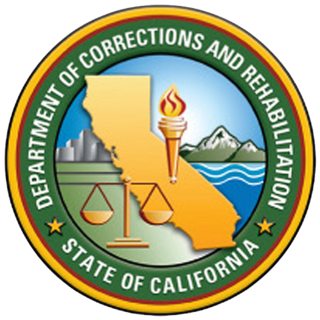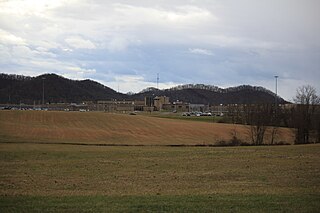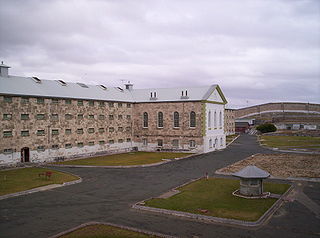Related Research Articles

Pelican Bay State Prison (PBSP) is a supermax prison facility in Crescent City, California. The 275-acre (111 ha) prison takes its name from a shallow bay on the Pacific coast, about 2 mi (3.2 km) to the west.

California State Prison, Corcoran (COR) is a male-only state prison located in the city of Corcoran, in Kings County, California. It is also known as Corcoran State Prison, CSP-C, CSP-COR, CSP-Corcoran, and Corcoran I. The facility is just north of the newer California Substance Abuse Treatment Facility and State Prison, Corcoran.

Incarceration in the United States is one of the primary means of punishment for crime in the United States. In 2023, over five million people were under supervision by the criminal justice system, with nearly two million people incarcerated in state or federal prisons and local jails. The United States has the largest known prison population in the world, it has 5% of the world’s population, and 20% of the world’s incarcerated persons. China, with four times more inhabitants, has fewer persons in prison. Prison populations grew dramatically beginning in the 1970s, but began a decline around 2009, dropping 25% by year-end 2021.

The rights of civilian and military prisoners are governed by both national and international law. International conventions include the International Covenant on Civil and Political Rights; the United Nations' Minimum Rules for the Treatment of Prisoners, the European Committee for the Prevention of Torture and Inhuman or Degrading Treatment or Punishment, and the Convention on the Rights of Persons with Disabilities.

Penal labour is a term for various kinds of forced labour that prisoners are required to perform, typically manual labour. The work may be light or hard, depending on the context. Forms of sentence involving penal labour have included involuntary servitude, penal servitude, and imprisonment with hard labour. The term may refer to several related scenarios: labour as a form of punishment, the prison system used as a means to secure labour, and labour as providing occupation for convicts. These scenarios can be applied to those imprisoned for political, religious, war, or other reasons as well as to criminal convicts.

Oregon State Penitentiary (OSP), also known as Oregon State Prison, is a maximum security prison in the northwest United States in Salem, Oregon. Originally opened in Portland 173 years ago in 1851, it relocated to Salem fifteen years later. The 2,242-capacity prison is the oldest in the state; the all-male facility is operated by the Oregon Department of Corrections (ODOC). OSP contains an intensive management wing, which is being transformed into a psychiatric facility for mentally ill prisoners throughout Oregon.

The Southern Ohio Correctional Facility is a maximum security prison located just outside Lucasville in Scioto County, Ohio. The prison was constructed in 1972. As of 2022, the warden is Donald Redwood.
A prison strike is an inmate strike or work stoppage that occurs inside a prison, generally to protest poor conditions or low wages for penal labor. Prison strikes may also include hunger strikes.
Red Onion State Prison (ROSP) is a supermax state prison located in unincorporated Wise County, Virginia, near Pound. Operated by the Virginia Department of Corrections (VADOC), it houses about 800 inmates. The prison opened in August 1998.

Punishment in Australia arises when an individual has been accused or convicted of breaking the law through the Australian criminal justice system. Australia uses prisons, as well as community corrections. When awaiting trial, prisoners may be kept in specialised remand centres or within other prisons.
Prison overcrowding in the United States is a social phenomenon occurring when the demand for space in a U.S. prison exceeds the capacity for prisoners. The issues associated with prison overcrowding are not new, and have been brewing for many years. During the United States' War on Drugs, the states were left responsible for solving the prison overcrowding issue with a limited amount of money. Moreover, federal prison populations may increase if states adhere to federal policies, such as mandatory minimum sentences. On the other hand, the Justice Department provides billions of dollars a year for state and local law enforcement to ensure they follow the policies set forth by the federal government concerning U.S. prisons. Prison overcrowding has affected some states more than others, but overall, the risks of overcrowding are substantial and there are solutions to this problem.

In the United States, penal labor is a multi-billion-dollar industry. Annually, incarcerated workers provide at least $9 billion in services to the prison system and produce more than $2 billion in goods. The industry underwent many transitions throughout the late 19th and early and mid 20th centuries. Legislation such as the Hawes-Cooper Act of 1929 placed limitations on the trade of prison-made goods. Federal establishment of the Federal Prison Industries (FPI) in 1934 revitalized the prison labor system following the Great Depression. Increases in prison labor participation began in 1979 with the formation of the Prison Industry Enhancement Certification Program (PIECP). The PIECP is a federal program first authorized under the Justice System Improvement Act of 1979. Approved by Congress in 1990 for indefinite continuation, the program legalizes the transportation of prison-made goods across state lines and allows prison inmates to earn market wages in private sector jobs that can go towards tax deductions, victim compensation, family support, and room and board.

Maafushi Prison is a prison in Maafushi on Kaafu Atoll in the Maldives, 18 miles (29 km) south of the capital, Malé. It is the largest prison on the islands and has held numerous political prisoners over the years, including the former president, Mohamed Nasheed and former president Abdulla Yameen.
St. Clair Correctional Facility is an Alabama state men's prison located in Springville, St. Clair County, Alabama. The prison was originally built in 1983, and has an operating capacity of 1,514 inmates. The current warden is Guy Noe.
The Free Alabama Movement (FAM) is an inmates rights group based in the United States. With the Incarcerated Workers Organizing Committee, the Free Alabama Movement has organized the 2016 U.S. prison strike that involved an estimated 24,000 prisoners in 24 states, the largest prison strike in U.S. history. The strike began on September 9, 2016, the 45th anniversary of the Attica Prison uprising.

TheIncarcerated Workers Organizing Committee (IWOC) is a prison-led section of the Industrial Workers of the World. Its purpose is 'a union for the incarcerated,' with the goal of abolishing prison slavery, as well as fighting to end the exploitation of working-class people around the world.
The 2016 U.S. prison strike was a prison work stoppage that began on September 9, 2016, the 45th anniversary of the Attica uprising. The strike occurred in 24 states, and over 24,000 prisoners took part in the strike. The involvement of 24,000 prisoners made this strike the largest ever recorded in the U.S. Within a week, inmates from approximately 20 prisons participated. Organizations involved in coordinating the strike included the Incarcerated Workers Organizing Committee and the Free Alabama Movement.
The Prisoner Human Rights Movement was launched in 2011 by Pelican Bay State Prison inmates in response to large numbers of inmates being moved from general prison populations to solitary-confinement units after allegations of gang affiliation or political organizing. Its goal is to improve living conditions for inmates in California.

Kevin "Rashid" Johnson is a revolutionary, writer, artist, social activist, founding member of the New Afrikan Black Panther Party, founding member of the Revolutionary Intercommunal Black Panther Party, member of the Incarcerated Workers Organizing Committee, and prisoner in the Ohio Department of Rehabilitation and Correction.
The 2010 Georgia prison strike was a prison strike involving prisoners at 7 prisons in the U.S. state of Georgia. The strike, organized by the prisoners using contraband cell phones, began on December 9 and ended on December 15. It was reported at the time to be the largest prison strike in United States history and was followed by similar strikes in several other states, as well as nationwide strikes several years later, in 2016 and 2018.
References
- 1 2 3 4 Kennedy, Merrit (August 21, 2018). "Inmates Plan To Hold Weeks-Long Strike At Prisons Across U.S." NPR.org. Retrieved 2018-08-22.
- 1 2 Neufeld, Jennie (22 August 2018). "Why the 2018 prison strike could be "one of the largest" in US history". Vox. Retrieved 2018-08-22.
- ↑ Suresh, Susmitha (2018-08-22). "National Prison Strike 2018 Largest In US History". International Business Times. Retrieved 2024-02-10.
- 1 2 Pilkington, Ed (August 21, 2018). "US inmates stage nationwide prison labor strike over 'modern slavery'". The Guardian. Retrieved September 13, 2018.
- 1 2 Fryer, Brooke (September 5, 2018). "US inmates sent to solitary confinement over 'prison slavery' strike". NITV News. Retrieved September 13, 2018.
- 1 2 Lartey, Jamiles (September 1, 2018). "US inmates claim retaliation by prison officials as result of multi-state strike". The Guardian. Retrieved February 14, 2020.
- 1 2 hlr (2019-03-08). "Striking the Right Balance: Toward a Better Understanding of Prison Strikes". Harvard Law Review. Retrieved 2024-02-10.
- 1 2 3 "Prison Strike 2018". Incarcerated Workers Organizing Committee. 2018-06-19. Retrieved 2018-08-22.
- ↑ Gross, Daniel A. (2018-09-06). "An Inside Account of the National Prisoners' Strike". The New Yorker. ISSN 0028-792X . Retrieved 2024-02-10.
- ↑ Lewis, Nicole (2018-08-24). "What's Really Happening With the National Prison Strike?". The Marshall Project. Retrieved 2024-02-10.
- ↑ "Imam Hasan conduct report July 27, 2018". Incarcerated Workers Organizing Committee. 29 August 2018. Retrieved 9 September 2018.
- ↑ Cantú, Aaron (August 27, 2018). "NM prison bosses lift statewide lockdown as activists claim protests by inmates". Santa Fe Reporter. Retrieved 9 September 2018.
- ↑ Jones, El (August 19, 2018). "The prisoners at the Burnside jail are engaged in a non-violent protest; here is their statement". Halifax Examiner. Retrieved 9 September 2018.
- ↑ Brown, Dalvin (August 21, 2018). "Prisoners nationwide go on strike to protest 'modern-day slavery'". USA Today. Retrieved 9 September 2018.
- ↑ Da Silva, Chantal (August 21, 2018). "U.S. Inmates Launching Nationwide Strike to 'End Prison Slavery'". Newsweek. Retrieved 9 September 2018.
- ↑ Corley, Cheryl (August 21, 2018). "U.S. Inmates Plan Nationwide Prison Strike To Protest Labor Conditions". National Public Radio. Retrieved 9 September 2018.
- ↑ "Detainee Speaks Out from Hunger Strike in Northwest Detention Center". Democracy Now!. August 27, 2018. Retrieved 9 September 2018.
- ↑ "With US Prison Strike on Third Day, Reports of Hunger Strikes and Work Stoppages Nationwide". Common Dreams. 23 August 2018. Retrieved 10 September 2018.
- ↑ "Protests at 2 N Carolina prisons as part of national strike". AP News. August 31, 2018. Retrieved 10 October 2023.
- ↑ Moretti, Enzo (September 18, 2018). "EOT273 NC Prison Protests 9/18/18". No. E273. WKNC 88.1 FM. Retrieved 10 October 2023.
- ↑ Pilkington, Ed (23 August 2018). "Major prison strike spreads across US and Canada as inmates refuse food". The Guardian. Retrieved 23 August 2018.